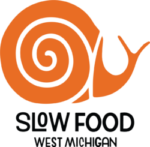2016 Grant Awardee Oragami Vegetables
There is a wide range of ancient Chinese and Korean vegetables unavailable in our market. Often the only plants available are imported from California, or elsewhere, and these are usually the standardized, hybrid daikon radish and napa cabbage. As interest in these traditional foods increases, so does the need for a local and sustainable source. Through Oragami Vegetable’s experience volunteering at an intensive, hand-sown heirloom farm in Ann Arbor, we know it is possible to produce a large variety of vegetables on a small farm . They want to provide a sustainable, local source of Asian vegetables for their community.
As interest in ferments is increasing and Asian-American communities are growing, people are beginning to seek out ingredients like Chinese cabbage and radish, which aren’t commonly grown in West Michigan. Soybeans, which in the US are a crop almost solely grown by Big agriculture, are a staple for many Asian cultures. As soybeans are genetically modified and heavily treated with hazardous, synthetic fertilizers and pesticides, they are a plant they would like to grow. There is a need for quality, fresh and seasonal Asian vegetables!
The varieties of Kimchi are endless. With Korean relatives, they have the chance to taste a wide variety of fresh, authentic Korean pickles. Some of their favorite kimchis include Chinese cabbage, Chinese radish, ponytail radish, ramp, garlic scapes, green onions, chwinamul greens, garlic and cucumbers. Fermenting vegetables protects nutrients, increases bioavailability and provides much needed probiotics. Fermenting also decreases the need to purchase out of season imported vegetables, since it preserves the summer’s harvest. We will be offering kimchi seminars in hopes of increasing awareness and interest in ferments made with local and seasonal ingredients.
The vegetables we’ve selected carry a rich history and offer a chance to connect to our roots and celebrate their traditional cultures, Asian and European. This is an opportunity to protect and pass on a diverse culture of plants and food preparations. Traditionally, communities gather after harvest and ferment large quantities of vegetables to preserve for the winter. In Korea this holiday is called Kimjang (김장). Another example of communities gathering to preserve the harvest is Pongol, or Sankranthi, in India. Their family gathers together to ferment big batches of sauerkraut in a manner similar to these traditions and they are passionate about sharing this with their community. The CSA will have a Kimjang party at the end of the season.
It is important to note that the CSA boxes aren’t limited to fermenting. Each CSA basket will provide various seasonal, heirloom vegetables that are wonderful raw or cooked in stew, stir fried, etc. Because of the exotic nature of some of the vegetable varieties, a detailed list of the vegetables and their characteristics will be given to each member along with recipe ideas.
Classes dedicated to Korean fermenting will be offered to nurture a basic understanding of this food tradition.
We will distribute flyers at Nourish Organic market, Fulton Street Farmer’s Market, The Downtown Market, Asian Groceries Store, Grand Valley University, GRCC. We are hoping to do demonstrations at Fulton Street Market, the Downtown Market and planning to connect with community organizations like Baxter Community Center, Allen Street Market, and the YMCA.
Plant varieties (exclusively organic, heirloom varieties):
Alliums:
- Meadow Garlic (Allium canadense)
- Green onions, Tokyo Long White Bunch Onion
- Chives/ chinese leek/ garlic chive (Allium tuberosum),Chinese Chives
- Nodding Onion/ Lady’s Leek (Allium cernuum)
- Wild Chives 달래
- Onions, Australian Brown Onion/Yellow of Parma Onion/Jaune Paille Des Vertus
Leafy Greens and bitters:
- Chwinamul 취나물 (Aster saber: the leaves of a flowering plant often fermented and
- Chamnamul 참나물(pimpinella brachycarpa)
- Shepherd’s purse/ shepherds sprout 씀바귀-고들빼기 (Crepidiastrum sonchifolium)
- Mustard greens, Japanese Giant Red Mustard Greens
- Mugwort (Artemisia vulgaris)
- Peppers, Korean Dark Green Pepper
- Cucumbers, Boston Pickling Cucumber /Empereur Alexandre Cucumber
Other Vegetables:
- Cabbage, Hilton
- Pumpkins (for kimchi paste)
- Carrots, Atomic Red Carrot/Cosmic Purple Carrot/Pusa Asita Black/Red Beauty
- Ponytail Radish, minowase/ China Rose/ Iwai Daikon/ Chinese Red Meat/ Leda/
- Radish, Daikon/ Chinese Green Luobo/ Alpine/Formosa Giant Luo Buo Radish
- Soybeans, Korean Green Cotyledon
Second year harvest:
- Garlic, Korean Red/ Korean Mountain (First year for seed; won’t harvest garlic until
- Spring cabbage 봄동 (Second year harvest. Napa cabbage grown over winter to
- Ginger grown indoors
- Burdock, Great Burdock
Seeds will be purchased from: Baker Creek Heirloom; Annie’s Heirloom Seeds (Hudsonville, MI); Seed Saver’s Exchange; and Johnny’s Selected Seeds.
Grant Application Information
